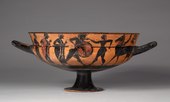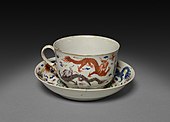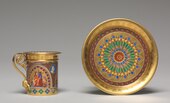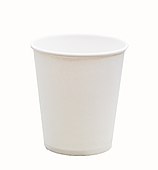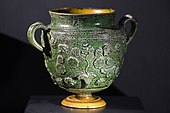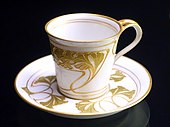Cup

A cup is an open-top container used to hold liquids for pouring or drinking typically with a flattened hemispherical shape, and often with a capacity of about 100–250 millilitres (3–8 US fl oz).[1][2] Although mainly used for drinking, it also can be used to store solids for pouring (e.g., sugar, flour, grains, salt).[3] Cups may be made of glass, metal, china,[4] pottery, wood, stone, bone, polystyrene, plastic, aluminum, or other materials. They also most typically have handles, though a beaker has no handle or stem. Cups are used across a wide range of cultures and social classes.[5]
Cups of different styles may be used for different types of liquids or other foodstuffs (e.g. teacups and measuring cups), in different situations (e.g. at water stations or in ceremonies and rituals), or for decoration.[6][7] The word "cup" is also used as a unit of capacity: the capacity of a "typical" cup, varying slightly from place to place.

The history of cups goes back well into prehistory, initially mostly as handle-less beakers or bowls, and they have been found in most cultures across the world.
Modern household shapes of cup generally lack a stem, but this was not always the case. The large metal standing cup or covered cup with a base and stem, and usually a cover, was an important prestige piece in medieval houses that could afford them, and often used as a "welcome cup", or for toasts. The form survives in modern sporting trophies, and in the chalices of church liturgy. The 15th-century silver Lacock Cup is a rare English secular survival.[8] These were the sort of cup offered by cup-bearers, historically often an important office in courts.
Definitions
[edit]The definition of a cup is fluid, and is likely to be wider in specialist areas such archaeology than in modern common speech. As an example, Anna Wierzbicka (1984) notes that in the 1970s the "older generation" expected a cup to be made of porcelain and have both a handle and a saucer, so that the plastic cup with neither a handle, nor a saucer, was not a "real cup", while the "younger generation" made no such distinction, and used "coffee cup" or "teacup" to indicate the traditional cups. Twelve-year-olds had two different shapes of a cup in mind, one for hot liquids, one for juices.[9]
Names for different types of cups vary regionally and may overlap (in American English "cups" include "mugs"[10]). Any transparent cup, regardless of actual composition, is more likely to be called a "glass"; therefore, while a flat-bottomed cup made of paper is a "paper cup", a transparent one for drinking shots, of very similar shape, is called a "shot glass", instead. Penelope Stock, a lexicographer, stated that cups, mugs and glasses are "near-synonyms", although "sufficient differences" can be found that divide them into different groups.[11]
Wierzbicka and Keith Allan (in his work "On Cup", 2020) compare definitions of the cup:[12][13]
| Trait | William Labov[14] | Jerrold J. Katz[15] | OED[2] | Cliff Goddard[16] | Webster's 2nd ed.[17] |
|---|---|---|---|---|---|
| Shape | Tapering, circular | Vertically oriented, "upwardly concave" | Hemispherical | Thin round sides, smooth top edge, flat bottom | Open, bowl-shaped |
| Proportions | Similar width and depth | Height close to the top diameter that is greater than the bottom one | Small | Not big, bottom narrower than top | Small |
| Function | Drinking hot liquids | Drinking | Drinking | Drinking hot liquids with one hand | "Chiefly" drinking, commonly used for hot liquids |
| Material | Opaque "vitreous" | Hard and smooth | |||
| Handle | One | Optional | One, in "many things" | Optional, one or more | |
| Saucer | Present | Present | Common | ||
| Stem | Uncommon (usually found in the chalice) | Optional | |||
| Lid | Uncommon, not part of the "cup" itself | Optional |

Many languages − including French, Italian, Polish, Russian, German − use two separate words for mugs and cups. Wierzbicka suggests that this situation is due to a slightly different functionality: the traditional cups are designed for drinking while sitting down at the table, while the mug is supposed to be used anywhere. This, in her opinion, explains all the specific features:[18]
- the saucer of the cup helps to protect the table surface, but is an inconvenience away from the table;
- the tapered shape of the cup accommodates the saucer, the cylindrical design of the mug is due to the absence of the saucer;
- larger handle of a mug allows carrying the mug around when putting it down is not an option;
- thicker walls of a mug allow cupping it with a second hand for convenience and reduce the chance of the mug being broken during long periods of handling;
- sitting at the table implies a more formal occasion, so cups are made to be more elegant, and sold in sets (like a tea set or a coffee service). Mugs are informal and usually sold individually;
- mug holds more liquid than the cup, as the latter is used in a close proximity of a teapot anyhow. Since limiting the area of the exposed surface of the liquid helps keeping the temperature, this increase in volume is achieved through mug being taller, while tapered cups are lower for stability.
History
[edit]
Cups have been used since prehistory and have been found at archeological sites throughout the world. Prehistoric cups were sometimes fashioned from shells and hollowed out stones,[20] The English word "cup" has meant a drinking vessel since at least 1000 AD.[21]
In ancient Mesopotamia, cups were made for a variety of purposes, possibly including the transportation and drinking of alcoholic beverages.[22]
The Bell Beaker culture, is an important archaeological culture named after the distinctive inverted-bell pottery beaker cups it used,[23] marking the beginning of the European Bronze Age from around 2800 BC. The Ringlemere Cup is a solid gold cup, with handle, from around 1600 BC, with the Rillaton Gold Cup one of two such cups known from England, with a handful of other locations and materials (such as the Hove amber cup) making up the "unstable" (round-bottomed) cups in precious materials from the Bronze Age.
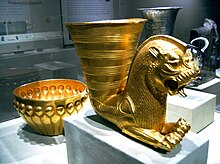
Animal horns must often have been used as cups from very early on, and the rhyton is a cup that imitates their shape, to a greater or lesser degree, in metal or pottery. It was the general elite type of cup throughout the Mediterranean in the Iron Age, from Greece to Ancient Persia and beyond. Only some had feet or bases that allowed them to be rested on a flat surface. Large numbers were decorated with or as animal heads, or terminated in the figure of an animal.
Other than the rhyton, ancient Greek drinking cup shapes were mostly very wide and shallow bowls, usually on short stems and with two handles, generally oriented along the same plane as the mouth of the cup, rather than at 90 degrees to it, as in modern teacups. Survivals in ancient Greek pottery are numerous, and often brilliantly painted, but all probably were made also in silver, where survivals are extremely rare, as grave robbers did not bother with pottery. The most important shapes are the kylix, kantharos, skyphos, lip cup, and the breast-shaped mastos with no base.[24]
The Roman Empire used cups throughout Europe, with "goblet"-type shapes with shortish stems preferred for luxury examples in silver, like the Warren Cup, or Roman glass, such as the Lycurgus Cup in color-changing glass,[25][26] or the spectacular carved-glass cage cups.
Cups were used in the Americas several centuries prior to the European arrivals.[27] Around the Gulf of Mexico, Native American societies used the shells of the Horse conch for drinking cups, among other purposes.[28]
In the Middle Ages the shapes of most ordinary cups were closer to mugs, tankards, and goblets rather than modern cups, but the elite preferred cups with stems, and often covers in metal, with glass a less common alternative. Large feasting drinking horn cups in horn, including ivory, had metal mounts. Chinese and Japanese tea cups were shaped like small bowls when they appeared in Europe in the 16th century;[21] in fact the same shapes are typically used in East Asia for both tea and wine or sake.
-
Ancient Egyptian lotiform cup; 1295-1185 BC; faience; height: 15 cm, diameter: 9.1 cm
-
Silver beaker, possibly Norwegian, second half of the 17th century, silver, overall: 9.2 × 8.3 cm
-
Ancient Greek kylix; 575-550 BC; black-figure terracotta; diameter: 26.8 cm, overall: 14.1 cm
-
Chinese export porcelain cup and saucer in the Western style with handle; 1745; diameter: 10.2 cm
-
Sèvres cabinet cup and saucer, decorated with Gothic Revival ornament; 1827; porcelain; overall: 8.2 x 10 cm
-
Typical modern-day, disposable paper cup
Cultural significance and use
[edit]
Since cups have been an integral part of dining since time immemorial, they have become a valued part of human culture.[29]
Monarchy
[edit]Historically, monarchs have been concerned about assassination via poisoning. To avoid this fate, they often used dedicated cups, with cup-bearers to guard them. A "divining cup" was supposed to be able to detect poison. In the Bible, Joseph interpreted a dream for Pharaoh's cup-bearer,[30] and a silver divining cup played a key role in his reconciliation with his brothers.
The Royal Gold Cup is an exceptionally rare survival, made before 1391 for John, Duke of Berry, a French prince, who gave it to his uncle, Charles VI of France. It is in gold, decorated with jewels and scenes in enamel, with a cover and a boiled leather carrying case. It once had a triangular stand which has been lost. It weighs 1.935 kilos, so was perhaps used ceremonially rather than throughout meals.[31]
Spa cups are special cups that are used to drink mineral or thermal water directly from a spring, developed in north-west Bohemia during the 17th century[32] and are now part of Czech folklore.
Religion
[edit]
In the Christian ritual of Communion, adherents drink from a cup of wine (or a wine substitute) to commemorate the Last Supper of Jesus.[33] A chalice is often used for this purpose. Ancient Greek religious practices included libations. The rhyton was one cup used for libations.
Cuisine
[edit]The measuring cup, an adaptation of a simple cup, is a standard tool in cooking that has been in use at least as far back as Roman times. Apart from serving as drinking vessels, cups can be used as an alternative to bowls as a receptacle, especially, for soup. Recipes have been published for cooking various dishes in cups in the microwave.[34]
Heraldry
[edit]Chalices are sometimes used in heraldry, especially ecclesiastical heraldry. A Kronkåsa is a type of elaborate wooden cup which was used by the Swedish nobility during the Renaissance.
Child development
[edit]Drinking from a cup is a significant step on a baby's path to becoming a toddler; it is recommended that children switch from bottles to cups between six months and one year of age.[35][36] Sippy cups are typically used for this transition.
Sports
[edit]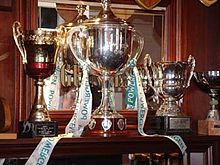
Many trophies take the form of a decorated cup. In cases such as the FIFA World Cup and the Stanley Cup, the competition itself may grow to take on the name of the trophy that is awarded to the winner. Owing to the common usage of cup-shaped trophies as prizes for the winners, a large number of national and international competitions are called "cups".[37]
Games
[edit]In Tarot divination, the suit of cups is associated with the element of water and is regarded as symbolizing emotion, intuition, and the soul.[38][39] Cards that feature cups are often associated with love, relationships, fears, and desires.[38][40]
Various cups have been designed so that drinking out of them without spilling is a challenge. These are called puzzle cups.
The cup game involves rhythmically striking plastic cups.[41]
Promotion
[edit]In the developed world, cups are often distributed for promotional purposes.[42] For example, a corporation might distribute cups with their logo at a trade show, or a city might hand out cups with slogans promoting recycling. There are companies that provide the service of printing slogans on cups.[43]
For hot beverages
[edit]
While in theory, most cups are well suited to hold drinkable liquids, hot drinks like tea are generally served in either insulated cups or porcelain teacups.
Metal and glass cups can use a double wall construction with a vacuum-sealed space in-between to reduce the loss of heat and keep outside surfaces cooler.[citation needed]
Disposable
[edit]
Disposable cups are intended to be used only once.[44] They are often used by fast-food restaurants and coffee shops to serve beverages. Institutions that provide drinking water, such as offices and hospitals, may also use disposable cups for sanitary reasons.
For alcoholic beverages
[edit]Some styles of cups are used primarily for alcoholic beverages such as beer, wine, cocktail, and liquor. There are over a dozen distinct styles of cups for drinking beer, depending on the precise variety of beer. The idea that a certain beer should be served in a cup of a certain shape may have been promulgated more for marketing purposes, but there very well may be some basis in fact behind it.[45] Wine glasses also come in different shapes, depending on the color and style of wine that is intended to be served in them.
- Beer stein
- Pint glass
- Old Fashioned glass
- Quaich[46]
- Sake cup (ochoko)
- Shot glass
- Tankard
- Wine glass
- Goblet
For measurement, suction and breasts
[edit]Gallery
[edit]-
Minoan Kamares ware; 1800-1700 BC; from Phaistos (Crete); Archaeological Museum of Heraklion (Heraklion, Crete, Greece)
-
Hittite drinking cup in the shape of a fist; 1400-1380 BC; silver; from Central Turkey; Museum of Fine Arts (Boston, USA)
-
Roman two-handled glazed cup; 1st century BC-4th Century AD; glazed terracotta; Erimtan Archaeology and Arts Museum (Ankara, Turkey)
-
Rectangular wine cup (Zun) with a dragon; 1700s; grayish-white jade; overall: 14 cm; Cleveland Museum of Art
-
Neoclassical coffee cup with saucer; circa 1790; jasper ware with relief decoration; diameter: 13.6 cm; by the Wedgwood Factory (England); Cleveland Museum of Art
-
French cup and saucer, decorated with Renaissance ornaments; 1880–1900; enamel and silver; overall: 6.5 x 8.5 x 6.5 cm; Cleveland Museum of Art
-
Art Nouveau cup; designed by Adolf Flad; 1902; porcelain; Bröhan Museum (Berlin, Germany)
References
[edit]- ^ Allan 2020, pp. 125–126, 129.
- ^ a b "cup". Oxford English Dictionary (Online ed.). Oxford University Press. doi:10.1093/OED/2023096574. (Subscription or participating institution membership required.)
- ^ "Cup - Definition and More from the Free Merriam-Webster Dictionary". Merriam-webster.com. August 31, 2012. Archived from the original on January 8, 2014. Retrieved January 26, 2014.
- ^ "Cup | Define Cup at Dictionary.com". Dictionary.reference.com. Archived from the original on October 7, 2015. Retrieved May 3, 2019.
- ^ Producer Chris. "Radio 1 Movies Blog: Who Drank From This? The Answer". BBC. Archived from the original on September 24, 2015. Retrieved January 26, 2014.
- ^ "What Are the Different Types of Coffee Cups? (with pictures)". Wisegeek.com. January 18, 2014. Archived from the original on February 1, 2014. Retrieved January 26, 2014.
- ^ Rigby 2003: p. 573–574.
- ^ "Cash-strapped church's £1.8m cup". BBC News. September 28, 2009. Retrieved October 29, 2024.
- ^ Wierzbicka 1984, pp. 214, 241–242, Note 20.
- ^ Kronenfeld 1996, p. 6.
- ^ Stock 2008, p. 131, page numbers are from the 1984 original.
- ^ Allan 2020, pp. 127–131.
- ^ Wierzbicka 1984, pp. 205–255.
- ^ Labov, William (1973). "The boundaries of words and their meanings". In Bailey, C.-J.; Shuy, R. (eds.). New ways of analyzing Variation in English. Washington D.C.: Georgetown University Press. pp. 340–373.
- ^ Katz, J. J. (1977). "A proper theory of names". Philosophical Studies: 1–80.
- ^ Goddard, Cliff (2011). Semantic analysis: A practical introduction (2nd ed.). Oxford: Oxford University Press.
- ^ Wierzbicka 1984, p. 205.
- ^ Wierzbicka 1984, pp. 214–216.
- ^ Ford, Peter (April 8, 2014). "At $36 million, 'chicken cup' cracks auction record for Chinese art". The Christian Science Monitor.
- ^ Examples include a hollowed stone used to hold pigment for cave painting (see History of technology), or mussel shells used to hold cosmetics. Examples of this style of cup have been found in Ancient Egyptian burials.
- ^ a b Allan 2020, p. 133.
- ^ "The Archaeology News Network: Gold cup headlines Mesopotamia exhibition". Archaeologynewsnetwork.blogspot.com. April 24, 2012. Archived from the original on January 20, 2013. Retrieved January 26, 2014.
- ^ So it struck early archaeologists. Actually it might be said that only the bottom of the beakers is bell-like; at the top nearly all have a "waist" below a flaring "lip".
- ^ See entries in Gisela M. A. Richter, Marjorie J. Milne, Shapes and Names of Athenian Vases, Metropolitan Museum of art, New York, 1935, fully online.
- ^ "Roman Cup - Archaeology Magazine Archive". Archaeology. March–April 2004. Archived from the original on February 2, 2014. Retrieved January 28, 2014.
- ^ Merali, Zeeya (September 2013). "This 1,600-Year-Old Goblet Shows that the Romans Were Nanotechnology Pioneers". Smithsonian. Archived from the original on February 1, 2014. Retrieved January 28, 2014.
- ^ Norton, Elizabeth (August 6, 2012). "Starbucks of Ancient America?". ScienceNOW. Archived from the original on February 1, 2014. Retrieved January 28, 2014.
- ^ Atlantic City Aquarium, Horse conch Archived May 15, 2014, at the Wayback Machine. Accessed April 26, 2014
- ^ Happy, Sharer (January 11, 2023). "The Invention of Cups: Exploring its Historical Origins and Impact on Society - The Enlightened Mindset". Retrieved October 25, 2024.
- ^ "Genesis 40 ESV - Joseph Interprets Two Prisoners' Dreams". Bible Gateway. Archived from the original on February 22, 2014. Retrieved January 26, 2014.
- ^ British Museum collection database. Royal Gold Cup. British Museum. Accessed January 11, 2023
- ^ Kuchyňová, Zdeňka (May 2, 2008). "Lázeňský pohárek - typicky česká záležitost" (in Czech). Czech Radio. Archived from the original on January 16, 2017. Retrieved January 15, 2017.
- ^ "Are You Drinking of the Master's Cup?". Cgg.org. Archived from the original on February 1, 2014. Retrieved January 26, 2014.
- ^ "Coffee Cup Quiche". St. Louis Post-Dispatch. May 1, 2012. Archived from the original on January 5, 2015. Retrieved February 9, 2014.
- ^ "Introducing a cup: 8 months and over". Heinz For Baby. Archived from the original on February 19, 2014. Retrieved January 26, 2014.
- ^ Last reviewed: July 2012 (January 1, 2000). "How can I encourage my toddler to drink from a cup?". BabyCentre. Archived from the original on February 2, 2014. Retrieved January 26, 2014.
{{cite web}}: CS1 maint: numeric names: authors list (link) - ^ "'win the cup' Google news search". Google. Archived from the original on May 8, 2014. Retrieved February 3, 2014.
- ^ a b Burger, Evelin; Johannes Fiebig (2004). Tarot Basics. New York: Sterling. p. 76. ISBN 1402730403.
- ^ Tarantino, P.C. (2007). Tarot for the New Aeon. Pebble Beach, CA: Alternative Insights. pp. 245–246. ISBN 978-0976618409.
- ^ Ziegler, Gerd (1988). Tarot: Mirror of the Soul: Handbook for the Aleister Crowley Tarot. York Beach, Maine: S. Weiser. p. 191. ISBN 0877286833.
- ^ "The Cup Game". Great Group Games. Archived from the original on July 30, 2014. Retrieved January 26, 2014.
- ^ Service, Industrial News. "Global consumer brands invest in promotional cups". Ins-news. Retrieved October 25, 2024.
- ^ "Custom Promotional Cups, Branded Plastic and Paper Cups". Custom On It. Archived from the original on January 22, 2014. Retrieved January 26, 2014.
- ^ Ashby, Michael F. (September 23, 2016). Materials Selection in Mechanical Design. Butterworth-Heinemann. ISBN 9780081006108.
- ^ Schneider, Drew (May 3, 2012). "A guide to beer glass types and their impact on flavour". Retrieved August 6, 2024.
- ^ McClenehan, Robert L. Some Scottish Quaichs. Illinois, 1955, p. 3.
Sources
[edit]- Allan, Keith (2020). "On Cups". Dynamics of Language Changes. Singapore: Springer Singapore. doi:10.1007/978-981-15-6430-7_8. ISBN 978-981-15-6429-1.
- Kronenfeld, D. (1996). Plastic Glasses and Church Fathers: Semantic Extension From the Ethnoscience Tradition. Oxford Studies in Anthropological Linguistics. Oxford University Press. ISBN 978-0-19-535749-3. Retrieved October 29, 2024.
- Rigby, Stephen Henry (2003). A Companion to Britain in the Later Middle Ages (Illustrated ed.). Wiley-Blackwell. ISBN 978-0-631-21785-5.
- Stock, Penelope F (January 24, 2008). "Polysemy" (PDF). Practical Lexicography. Oxford University Press. pp. 153–160. doi:10.1093/oso/9780199292332.003.0010. ISBN 978-0-19-929233-2.
- Wierzbicka, Anna (1984). "Cups and mugs: Lexicography and conceptual analysis". Australian Journal of Linguistics. 4 (2). Informa UK Limited: 205–255. doi:10.1080/07268608408599326. ISSN 0726-8602.
External links
[edit] Media related to Cups at Wikimedia Commons
Media related to Cups at Wikimedia Commons- Gallery of cups in The Metropolitan Museum of Art



